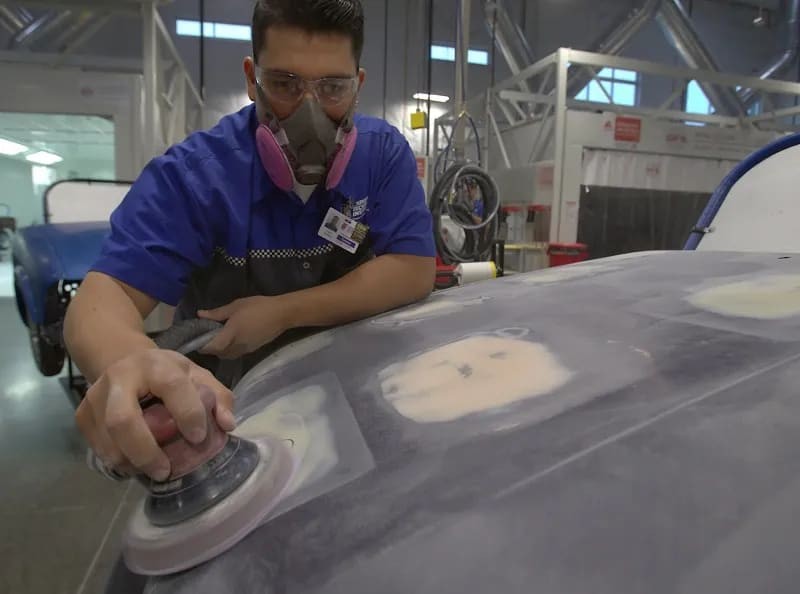Plastic components have become increasingly prevalent in modern vehicle design since the late 1960s, when the Pontiac Endura introduced a plastic-coated bumper. Today, plastics, both reinforced and unreinforced, are used extensively in car bodies for everything from bumpers and body panels to interior trims. While offering benefits like reduced weight and design flexibility, these plastic parts are susceptible to damage from collisions and everyday wear and tear. Knowing how to repair plastic car panels is a valuable skill for both car owners and automotive professionals. This guide will walk you through the essential steps and techniques for effectively repairing plastic car panels, ensuring a seamless and durable finish.
Understanding Types of Plastic for Car Panel Repair
Before attempting any repair, it’s crucial to identify the type of plastic your car panel is made from. Automotive manufacturers use various polymers, and using the wrong repair method or product can lead to further damage or a failed repair. Collision repair technicians rely on identifiers, often abbreviations molded into the part itself, to determine the plastic type. These markings are standardized by the International Standards Organization (ISO) and are critical for proper recycling and repair. Common plastic types you might encounter include:
- PP (Polypropylene): Known for its chemical resistance and flexibility.
- PO (Polyolefin): A general term for polymers like polyethylene and polypropylene.
- ABS (Acrylonitrile Butadiene Styrene): Rigid and impact-resistant plastic, often used for grilles and some interior parts.
- PC (Polycarbonate): Strong and transparent, used in headlight lenses (though not body panels).
- PE (Polyethylene): Flexible and impact-resistant, used in some bumpers.
- PVC (Polyvinylchloride): Less common in exterior panels but may be found in trims.
Identifying the plastic type will guide you in choosing the correct adhesives, fillers, and welding techniques for a successful and lasting repair.
Step-by-Step Guide: Repairing Plastic Car Panels
Plastic car panel repairs generally fall into two categories: cosmetic and two-sided. Cosmetic repairs address surface imperfections, while two-sided repairs are necessary for damage that penetrates the panel’s thickness.
Essential Tools and Materials for Plastic Repair
Having the right tools and materials is essential for effective plastic repair. Here’s a list of common items you’ll need:
- Plastic Welder: For melting and fusing plastic pieces together, crucial for two-sided repairs.
- Adhesives: Specifically designed for plastic repair, available in various strengths and curing times.
- Fillers: Plastic body fillers to smooth out dents and imperfections.
- Sanding Tools: Various grits of sandpaper, sanding blocks, and potentially a power sander for larger areas.
- Cleaning Products: Plastic cleaners and degreasers to remove waxes, grease, and dirt.
- Heat Gun (Optional): Can be helpful for softening nonreinforced plastics and shaping.
- Safety Gear: Gloves, eye protection, and a respirator, especially when sanding and using chemicals.
Preparing the Damaged Panel
Proper preparation is key to a successful plastic repair. Follow these steps:
- Cleaning: Thoroughly clean the damaged area and surrounding panel with plastic cleaner and degreaser. Remove all dirt, wax, grease, and road oils that could interfere with adhesion or welding. Compressed air can also be used to remove debris.
- Assessment: Carefully assess the damage. Determine if it’s cosmetic (scratches, minor dents) or two-sided (tears, holes). For two-sided damage, check for missing pieces and the extent of the structural damage.
 Technician using plastic welding tools to repair a car bumper
Technician using plastic welding tools to repair a car bumper
Repairing Cosmetic Damage (Scratches, Minor Dents)
For minor scratches and dents, you can often achieve excellent results with fillers and refinishing techniques:
- Sanding: Lightly sand the scratched or dented area to create a key for the filler to adhere to. Use progressively finer grits of sandpaper to smooth the surface.
- Applying Filler: Apply a thin layer of plastic body filler to the damaged area, following the manufacturer’s instructions. Build up thin layers as needed, allowing each layer to dry and cure properly.
- Shaping and Sanding: Once the filler is cured, sand it down to the desired shape, blending it seamlessly with the surrounding panel. Start with coarser grit sandpaper and gradually move to finer grits for a smooth finish.
- Priming and Painting: Apply plastic primer to the repaired area and then paint to match the vehicle’s color. Clear coat for added protection and shine.
Repairing Two-Sided Damage (Tears, Holes)
Repairing holes and tears requires more robust techniques like plastic welding or adhesive bonding:
- Alignment: Carefully align the broken pieces of the plastic panel as closely as possible.
- Plastic Welding (for compatible plastics): If you have a plastic welder and the plastic type is weldable, use plastic welding to fuse the pieces together. Heat the edges of the plastic along the crack or tear and melt them together, effectively rejoining the panel.
- Plastic Welding Techniques: Plastic welding involves using a specialized tool to heat and melt the plastic, allowing you to fuse broken pieces or fill gaps with molten plastic. Practice on scrap plastic to get a feel for the process before working on your car panel.
- Adhesive Bonding (for various plastics): For plastics that are not easily weldable or for added strength in conjunction with welding, use plastic adhesives. Apply adhesive to the edges of the broken pieces and clamp them together until the adhesive cures.
- Adhesive Bonding Methods: Choose a high-quality plastic adhesive suitable for automotive applications. Follow the manufacturer’s instructions for surface preparation, application, and curing time.
- Reinforcement (Optional): For larger or structurally significant repairs, consider reinforcing the back of the repair with fiberglass mesh or a similar material embedded in plastic resin or adhesive for added strength.
- Filling and Finishing: Once the structural repair is complete and cured, use plastic filler to smooth out any seams or imperfections. Sand, prime, and paint as described for cosmetic repairs to achieve a flawless finish.
Refinishing for a Seamless Look
After any plastic repair, refinishing is crucial to ensure the repaired area blends seamlessly with the rest of the vehicle. Refinish technicians are experts in this process, preparing the surface, matching colors, and applying paint and clear coat for a factory-like finish. This often involves:
- Color Matching: Accurately matching the vehicle’s existing paint color is vital. This might involve using paint codes and potentially custom tinting to achieve a perfect match.
- Blending: Blending the new paint into the surrounding original paint to avoid noticeable lines or color differences.
- Clear Coating: Applying a clear coat to protect the paint, add shine, and ensure durability.
DIY vs. Professional Plastic Car Panel Repair
While many minor plastic car panel repairs can be successfully tackled at home with the right tools and guidance, there are situations where professional help is recommended.
DIY Repair is suitable for:
- Minor cosmetic damage like scratches and small dents.
- Repairs on older or lower-value vehicles where a perfect finish may not be critical.
- Car owners comfortable with basic auto repair and refinishing techniques.
Professional Repair is recommended for:
- Significant structural damage or two-sided repairs, especially on critical body panels.
- Modern vehicles with advanced driver-assistance systems (ADAS), as improper repairs near sensor locations can cause malfunctions.
- High-value vehicles where a flawless, factory-quality finish is desired.
- Complex plastic types or repairs requiring specialized equipment like advanced plastic welding systems.
Professionals in collision repair shops have the expertise, experience, and specialized tools to handle a wide range of plastic car panel repairs, ensuring durability, safety, and a visually perfect finish. For those interested in pursuing this career path, programs like the Collision Repair & Refinish Technology (CRRT) program offer comprehensive training in automotive plastic repair techniques and refinishing.
Conclusion
Knowing how to repair plastic car panels empowers you to address damage effectively, whether through DIY methods for minor issues or by understanding when to seek professional assistance. By correctly identifying the plastic type, using appropriate repair techniques like plastic welding or adhesive bonding, and mastering refinishing processes, you can restore damaged plastic car panels to their original condition, maintaining the appearance and value of your vehicle.

